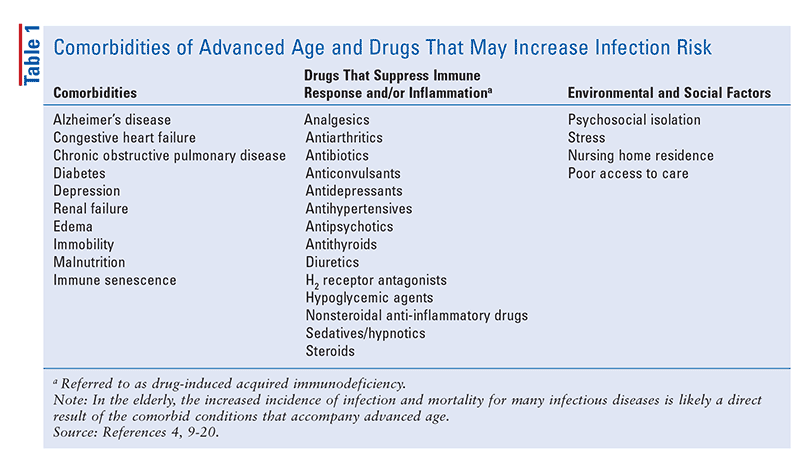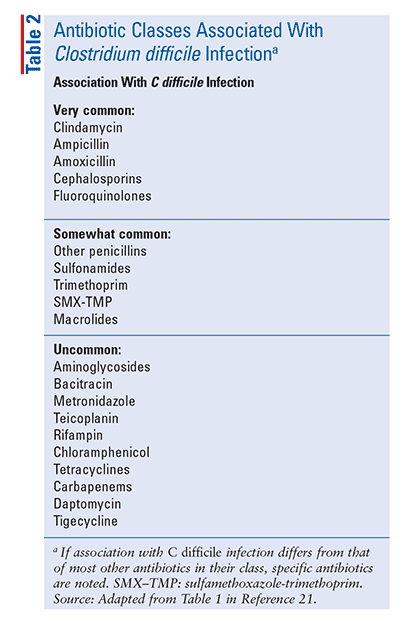US Pharm.2019;44(4):6-12.
Infectious diseases continue to be a major cause of mortality in older adults, accounting for one-third of all deaths in people aged 65 years and older, despite advances in antibiotic therapy.1 Special challenges arise when managing infections in older adults, owing to nuances of diagnosis and medication therapy; this article addresses some of these issues and provides tips, study data, and resources to assist with addressing these challenges.1
Comorbidities and Drugs Contributing to Infection
Aging is typically associated with mild-to-moderate changes within the immune system; a more profound deficit in immune function occurs as people advance in age. Susceptibility to infection in older adults increases in association with certain common comorbidities and medication therapy (TABLE 1). For example, pneumonia or a urinary tract infection (UTI) in the elderly may have a more subtle, atypical presentation, or a patient may exhibit a change in mental status or mild malaise as the only clinical indication of infection.1 Medication-induced immunodeficiency is considered reversible and should be carefully addressed during deprescribing reviews for the older patient.
Prevention strategies in older adults are most appropriate when they involve the consideration of estimated life expectancy and time to benefit for a preventive intervention (e.g., influenza vaccination).2
With a focus on person-centered approaches to prevention and screening, attention must be paid to frank discussions of benefits and harms in the context of the patient’s values and preferences.2
Antibiotic overuse can lead to an increased risk of diarrhea, resistant organisms, and infection caused by Clostridium difficile (TABLE 2).3
While the saying “start low, go slow” is associated with the medication treatment of older adults, it should not be applied to the initial antibiotic dosing for serious infections in this patient population, in whom a significant contributor to outcome is time to effective treatment.4
Naturally, dose adjustments of antibiotic agents are necessary if renal or hepatic function dictates.4 It should be underscored that delivering full initial antibiotic dosing in situations where subsequent renally or hepatically adjusted doses are warranted is critically important.4
VA Study on ADEs
Recently, researchers conducted a comprehensive adverse drug event (ADE) data assessment from a large integrated national healthcare system, the U.S. Department of Veterans Affairs (VA).5 As part of an ongoing national quality-improvement effort, Moore and colleagues used the VA’s Adverse Drug Event Reporting System (VA ADERS) to provide a robust picture of ADEs across age ranges—older adults are included in four age ranges—by incidence, severity, and associated causative agents.5 Their analysis revealed a nonlinear relationship between age and adverse events, with events peaking at 60 to 69 years of age. This study was a retrospective database review of 484,351 ADEs; compared with younger patients, older adults experienced a higher rate of severe ADEs.
For the purpose of this discussion, TABLE 3 and TABLE 4 have been adapted from the Moore study data to outline: (1) the antibiotic agents that rank in the top 20 drugs reported to VA ADERS as the primary suspect agent by age group; and (2) the antibiotic agents that rank in the top 20 drugs from severe reports disclosed to VA ADERS as the primary suspect drug by age group. Pharmacists are encouraged to review these tables for antibiotic ranking and examine the entire study (see Reference 5). Notably, the drugs that were commonly associated with ADEs had a tendency to be those mostly used for mental health disorders and for the treatment of pain in younger patients, as well as drugs used in the treatment of chronic illness in older patients.5
Culture Stewardship
Chronic asymptomatic bacteriuria is frequent in long-term care settings, with prevalence as high as 50%.6 In the absence of localized UTI symptoms (i.e., frequency, urgency, dysuria), the value of a positive urine culture in identifying whether a patient’s symptoms are caused by a UTI is limited.7 Restricting the collection of culture samples to only those clinical conditions where they are of clear benefit is referred to as culture stewardship.4 The practice of culture stewardship is prudent with regard to asymptomatic bacteriuria (e.g., asymptomatic colonization) in older adults; by limiting culture samples to only those clinical conditions where there is obvious benefit, unnecessary antibiotics are avoided.4
When evidence of infection is strong (e.g., new-onset fever, delirium), a culture is sought; to avoid misleading results, obtaining samples from swabbing the skin or taking urine from a long-term indwelling catheter is avoided.4
Adherence and Education
There have been promising results regarding the effectiveness of medication adherence programs in keeping patients on track with taking their prescriptions. Certain factors may alter different programs’ guidelines, but six elements that are essential for any intervention designed to improve medication adherence have been proposed: patient knowledge, counseling and accountability, providing support, self-monitoring, costs, personalizing the program, and need for future research. TABLE 5 provides tips on medication adherence counseling guidance for the pharmacist.
A Note on Rural Aging
There is a great need for geriatric healthcare providers in rural areas to address patients with multiple chronic conditions. Pharmacists should be aware, and consider in their delivery of care, that seniors residing in rural areas have high rates of disability and poverty; these factors increase the risk for adverse health outcomes.8 To address this need and increase access to care for rural older adults, the federal government has initiated a number of special programs.8 Pharmacists should explore the meaningful opportunities to serve this population in need of ongoing comprehensive medication therapy management and collaborate with other geriatric healthcare team members and providers.
Conclusion
By maintaining an awareness of atypical presentations of infections in older adults, the antibiotics most often reported as suspects in causing ADEs, practicing culture stewardship, and following guidelines to improve medication adherence, pharmacists may effectively manage the challenges of treating infections in this vulnerable patient population.
REFERENCES
1. Mouton CP, Bazaldua OV, Pierce B, et al. Common infections in older adults. Am Fam Physician. 2001;63(2):257-269.
2. Sei J. Lee; Louise C. Walter. Prevention and screening. In: Halter JB, Ouslander JG, Studenski S, et al, eds. Hazzard’s Geriatric Medicine and Gerontology. 7th ed. New York, NY: McGraw-Hill Education; 2017: Chapter 13.
3. Zabarsky TF, Sethi AK, Donskey CJ. Sustained reduction in inappropriate treatment of asymptomatic bacteriuria in a long-term care facility through an educational intervention. Am J Infect Control. 2008;36(7):476-480.
4. High KP. Infection: general principles. In: Halter JB, Ouslander JG, Studenski S, et al, eds. Hazzard’s Geriatric Medicine and Gerontology. 7th ed. New York, NY: McGraw-Hill Education. 2017; Chapter 125.
5. Moore VR, Glassman PA, Au A, et al. Adverse drug reactions in the Veterans Affairs healthcare system: frequency, severity, and causative medications analyzed by patient age. Am J Health-Syst Pharm. 2019;76(5):312-319.
6. Drinka P. Treatment of bacteriuria without urinary signs, symptoms, or systemic infectious illness (S/S/S). J Am Med Dir Assoc. 2009;10(8):516-519.
7. Stefanacci RG, Khan T. Can managed care manage polypharmacy? In Zagaria MA ed. Polypharmacy. Clin Geriatr Med. 2017;33(2):241-255.
8. Bellamy G, Speights A, Brummel-Smith K. Rural aging. In: Halter JB, Ouslander JG, Studenski S, et al, eds. Hazzard’s Geriatric Medicine and Gerontology. 7th ed. New York, NY: McGraw-Hill Education; 2017: Chapter 22.
9. Tummala MK, Taub DD, Ershler WB. Clinical immunology: immune senescence and the acquired immune deficiency of aging. In: Fillit HM, Rockwood K, Woodhouse K, eds. Brocklehurst’s Textbook of Geriatric Medicine and Gerontology. 7th ed. Philadelphia, PA: Saunders Elsevier; 2010:82-90.
10. Gelinck LB, Teng YK, Rimmelzwaan GF, et al. Poor serological responses upon influenza vaccination in patients with rheumatoid arthritis treated with rituximab. Ann Rheum Dis. 2007;66(10): 1402-1403.
11. Gelinck LB, van der Bijl AE, Beyer WE, et al. The effect of anti-tumour necrosis factor alpha treatment on the antibody response to influenza vaccination. Ann Rheum Dis. 2008;67(5):713-716.
12. Gelinck LB, van der Bijl AE, Visser LG, et al. Synergistic immunosuppressive effect of anti-TNF combined with methotrexate on antibody responses to the 23 valent pneumococcal polysaccharide vaccine. Vaccine. 2008;26(27-28):3528-3533.
13. Godwin JE. Neutropenia. Medscape.com. Updated September 18, 2018 http://emedicine.medscape.com/article/204821-overview#showall. Accessed March 22, 2019.
14. What is lymphocytopenia? National Heart, Lung, and Blood Institute. www.nhlbi.nih.gov/health-topics/lymphocytopenia. Accessed March 22, 2019.
15. Zagaria MA. Predisposition to infection in the elderly. US Pharm. 2011;36(8):28-31.
16. Sandman PO, Adolfsson R, Nygren C, et al. Nutritional status and dietary intake in institutionalized patients with Alzheimer’s disease and multiinfarct dementia. J Am Geriatr Soc. 1987;35(1):31-38.
17. Levine B, Kalman J, Mayer L, et al. Elevated circulating levels of tumor necrosis factor in severe chronic heart failure. N Engl J Med. 1990;323(4):236-241.
18. Plaut M. Lymphocyte hormone receptors. Annu Rev Immunol. 1987;5:621-669.
19. Glaser R, MacCallum RC, Laskowski BF, et al. Evidence for a shift in the Th-1 to Th-2 cytokine response associated with chronic stress and aging. J Gerontol A Biol Sci Med Sci. 2001;56(8):M477-M482.
20. Guidi L, Bartoloni C, Frasca D, et al. Impairment of lymphocyte activities in depressed aged subjects. Mech Ageing Dev. 1991;60(1):13-24.
21. Leffler DA, Lamont JT. Clostridium difficile infection. N Eng J Med. 2015; 372:1539-1548.
22. 6 Essential Elements for medication adherence programs. November 22, 2013. ASC Communications. www.beckershospitalreview.com/quality/6-essential-elements-for-medication-adherence-programs.html?tmpl=component&print=1&layout=default. Accessed March 22, 2019.
23. Appold K. Nine ways to help patients better adhere to their medications. March 5, 2019. www.drugtopics.com/medication-adherence/nine-ways-help-patients-better-adhere-their-medications. Accessed March 13, 2019.
To comment on this article, contact rdavidson@uspharmacist.com.










